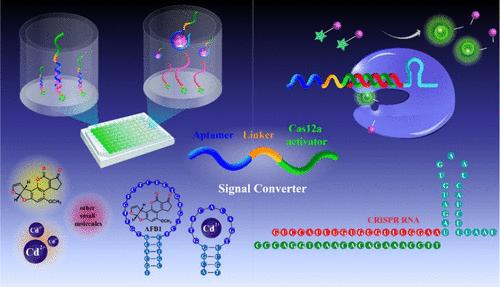当前位置:
X-MOL 学术
›
Anal. Chem.
›
论文详情
Our official English website, www.x-mol.net, welcomes your feedback! (Note: you will need to create a separate account there.)
CRISPR/Cas12a-Amplified Aptamer Switch Microplate Assay for Small Molecules
Analytical Chemistry ( IF 7.4 ) Pub Date : 2024-04-22 , DOI: 10.1021/acs.analchem.4c01452 Fengxi Zhu 1, 2 , Hao Yu 1, 2 , Qiang Zhao 1, 2, 3
Analytical Chemistry ( IF 7.4 ) Pub Date : 2024-04-22 , DOI: 10.1021/acs.analchem.4c01452 Fengxi Zhu 1, 2 , Hao Yu 1, 2 , Qiang Zhao 1, 2, 3
Affiliation

|
The presence of small molecule contaminants such as mycotoxins and heavy metals in foods and the environment causes a serious threat to human health and huge economic losses. The development of simple, rapid, sensitive, and on-site methods for small molecule pollutant detection is highly demanded. Here, combining the advantages of structure-switchable aptamer-mediated signal conversion and CRISPR/Cas12a-based signal amplification, we developed a CRISPR/Cas12a-amplified aptamer switch assay on a microplate for sensitive small molecule detection. In this assay, a short DNA strand complementary to the aptamer (cDNA) is immobilized on a microplate, which can capture the aptamer-linked active DNA probe (Apt-acDNA) in the sample solution when the target is absent. With the addition of the Cas12a reporter system, the captured Apt-acDNA probes activate Cas12a to indiscriminately cleave fluorescent DNA substrates, producing a high fluorescence signal. When the target is present, the Apt-acDNA probe specifically binds to the target rather than hybridizing with cDNA on the microplate, and the fluorescence signal is reduced. The analytical performance of our method was demonstrated by the detection of two highly toxic pollutants, aflatoxin B1 (AFB1) and cadmium ion (Cd2+), as examples. The assay exhibited good selectivity and high sensitivity, with detection limits of 31 pM AFB1 and 3.9 nM Cd2+. It also allowed the detection of targets in the actual sample matrix. With the general signal conversion strategy, this method can be used to detect other targets by simply changing the aptamer and cDNA, showing potential practical applications in broad fields.
中文翻译:

用于小分子的 CRISPR/Cas12a 扩增适体开关微孔板测定
食品和环境中霉菌毒素、重金属等小分子污染物的存在,对人类健康造成严重威胁并造成巨大经济损失。迫切需要开发简单、快速、灵敏、现场的小分子污染物检测方法。在这里,结合结构可切换适体介导的信号转换和基于 CRISPR/Cas12a 的信号放大的优点,我们开发了一种在微孔板上进行 CRISPR/Cas12a 放大的适体开关测定,用于灵敏的小分子检测。在该测定中,将与适体(cDNA)互补的短DNA链固定在微孔板上,当靶标不存在时,它可以捕获样品溶液中的适体连接的活性DNA探针(Apt-acDNA)。通过添加Cas12a报告系统,捕获的Apt-acDNA探针激活Cas12a,无差别地切割荧光DNA底物,产生高荧光信号。当靶标存在时,Apt-acDNA 探针与靶标特异性结合,而不是与微孔板上的 cDNA 杂交,荧光信号减弱。以黄曲霉毒素 B1 (AFB1) 和镉离子 (Cd 2+ )两种剧毒污染物为例,证明了我们方法的分析性能。该测定具有良好的选择性和高灵敏度,检测限为 31 pM AFB1 和 3.9 nM Cd 2+。它还允许检测实际样品基质中的目标。通过通用的信号转换策略,该方法可以通过简单地改变适配体和cDNA来检测其他靶标,显示出潜在的广泛领域的实际应用。
更新日期:2024-04-22
中文翻译:

用于小分子的 CRISPR/Cas12a 扩增适体开关微孔板测定
食品和环境中霉菌毒素、重金属等小分子污染物的存在,对人类健康造成严重威胁并造成巨大经济损失。迫切需要开发简单、快速、灵敏、现场的小分子污染物检测方法。在这里,结合结构可切换适体介导的信号转换和基于 CRISPR/Cas12a 的信号放大的优点,我们开发了一种在微孔板上进行 CRISPR/Cas12a 放大的适体开关测定,用于灵敏的小分子检测。在该测定中,将与适体(cDNA)互补的短DNA链固定在微孔板上,当靶标不存在时,它可以捕获样品溶液中的适体连接的活性DNA探针(Apt-acDNA)。通过添加Cas12a报告系统,捕获的Apt-acDNA探针激活Cas12a,无差别地切割荧光DNA底物,产生高荧光信号。当靶标存在时,Apt-acDNA 探针与靶标特异性结合,而不是与微孔板上的 cDNA 杂交,荧光信号减弱。以黄曲霉毒素 B1 (AFB1) 和镉离子 (Cd 2+ )两种剧毒污染物为例,证明了我们方法的分析性能。该测定具有良好的选择性和高灵敏度,检测限为 31 pM AFB1 和 3.9 nM Cd 2+。它还允许检测实际样品基质中的目标。通过通用的信号转换策略,该方法可以通过简单地改变适配体和cDNA来检测其他靶标,显示出潜在的广泛领域的实际应用。



























 京公网安备 11010802027423号
京公网安备 11010802027423号